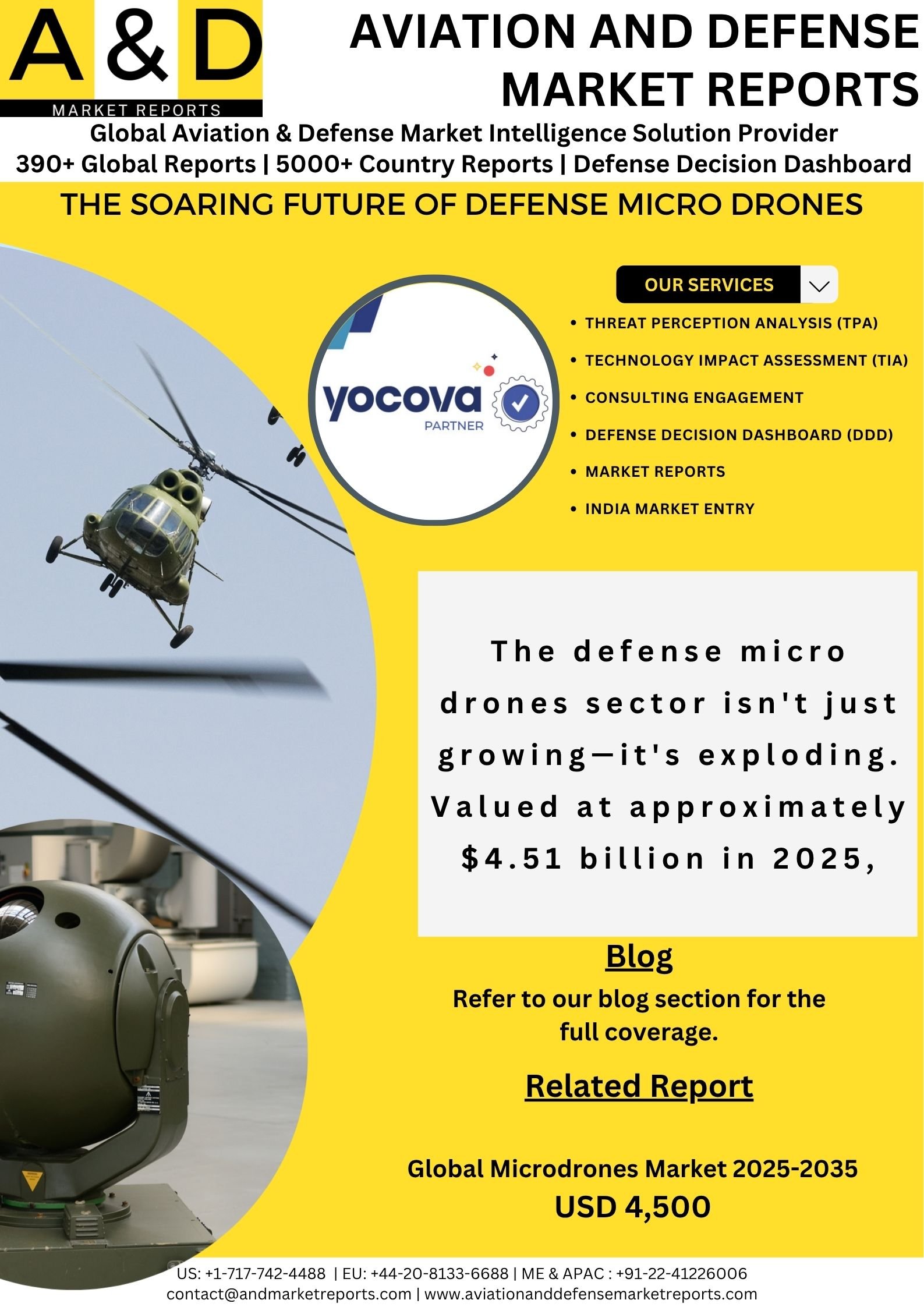In the high-stakes world of modern warfare, where battles are won not just on the ground but in the skies above, micro drones have emerged as game-changers. These pint-sized powerhouses—often no larger than a hummingbird—pack surveillance, reconnaissance, and even strike capabilities into a package that’s stealthy, affordable, and deployable in swarms. As of September 2025, with conflicts from Ukraine to the Middle East showcasing their battlefield dominance, the defense micro drones market is buzzing with unprecedented growth. But what’s driving this boom? In this 1000-word deep dive, we’ll explore market dynamics, key players, cutting-edge trends, persistent challenges, and a glimpse into tomorrow’s skies.
Market Size and Explosive Growth
The defense micro drones sector isn’t just growing—it’s exploding. Valued at approximately $4.51 billion in 2025, the global micro drone market is forecasted to skyrocket to $21.33 billion by 2035, boasting a compound annual growth rate (CAGR) of 16.8%. This surge is fueled by escalating geopolitical tensions and the need for cost-effective, real-time intelligence in asymmetric warfare. Broader military drone markets echo this momentum: the overall UAV segment is projected to hit $22.81 billion by 2030, up from $15.80 billion this year, with micro variants leading the charge due to their low cost—often under $1,000 per unit—versus multimillion-dollar predators.
Small drones, which include micros under 250 grams, are a subset stealing the spotlight. The small drone market is expected to balloon from $27.34 billion in 2025 to $128.75 billion by 2032, at a blistering 24.8% CAGR. Defense applications dominate, accounting for over 40% of demand, as militaries pivot from legacy systems to agile, disposable tech. North America holds the lion’s share, thanks to hefty U.S. Department of Defense budgets topping $850 billion annually, but Asia-Pacific is nipping at its heels with China’s aggressive R&D investments.
This growth isn’t hype; it’s hardware meeting havoc. In Ukraine, micro drones have neutralized tanks worth millions for pennies on the dollar, proving their ROI in real time. As budgets tighten post-pandemic, procurement officers are eyeing micros for their scalability—deploy hundreds for the price of one large UAV.
Key Players Shaping the Battlefield
Behind these tiny titans are innovation powerhouses turning sci-fi into standard issue. AeroVironment (AVAV) tops the list with its Switchblade loitering munitions, a micro-drone hybrid that’s become a staple for U.S. forces. Valued at over $3 billion in market cap, AVAV’s portfolio emphasizes portable, soldier-launched systems that blend reconnaissance with precision strikes.
Kratos Defense (KTOS) follows closely, specializing in affordable attritable drones like the XQ-58 Valkyrie, scaled down for micro ops. Their focus on unmanned autonomy has snagged contracts worth $500 million from the Pentagon. On the global stage, Teledyne FLIR’s Black Hornet Nano—a 33-gram marvel with 25-minute flight time and HD video—equips elite units from the British SAS to Norwegian special forces. Acquired in 2016, it’s now a cornerstone of NATO’s micro-drone doctrine.
Don’t sleep on the heavyweights: Northrop Grumman and Raytheon Technologies lead with integrated systems, blending micros into larger swarm networks. China’s National University of Defense Technology (NUDT) is a wildcard, unveiling mosquito-sized micros in June 2025 for covert ops—capable of infiltrating buildings undetected. Other notables include General Atomics (famed for Predators but dipping into micros), Lockheed Martin, BAE Systems, and Elbit Systems, whose Skylark series dominates Israeli exports.
These players aren’t just building drones; they’re engineering ecosystems—sensors, AI payloads, and counter-drone jammers—to lock in market share. In 2025 alone, mergers like Teledyne’s expansions signal consolidation, with the top five firms controlling 60% of the pie.
Emerging Trends: From Swarms to Stealth
Technology is the turbocharger here. Swarm intelligence tops the trends, where hundreds of micros coordinate via AI for overwhelming attacks—think a digital wolf pack. By 2030, expect fully autonomous swarms making split-second decisions without human input, as seen in DARPA’s OFFSET program. Stealth is another frontier: low-observable coatings and bio-mimicry (flapping wings like insects) render these drones nearly invisible to radar.
AI integration is revolutionizing ops. Onboard processing enables edge computing—real-time target ID and evasion—reducing latency from seconds to milliseconds. Loitering munitions, or “kamikaze” drones, are evolving too: Teledyne’s latest pack 20% more explosives while shrinking size. Modular designs allow swaps for payloads—ISR one minute, electronic warfare the next—boosting versatility.
Sustainability creeps in with solar-rechargeable batteries extending endurance from 20 to 60 minutes. And counter-drone tech? It’s flipping the script: micros now double as jammers, disrupting enemy swarms mid-flight. The Russia-Ukraine war has accelerated this, with 80% of battlefield intel now drone-sourced.
Navigating Challenges: Size Isn’t Everything
For all their promise, micro drones face hurdles that could ground ambitions. Battery life remains a bottleneck—most fly 15-30 minutes, limiting deep-strike potential. Harsh environments (dust, EMPs) chew through delicate components, demanding ruggedized designs that hike costs 20-30%.
Security vulnerabilities loom large: commercial-off-the-shelf (COTS) tech in many micros invites hacking, as exposed in recent Iranian intercepts of U.S. prototypes. Swarms amplify this—coordinating 100+ units risks signal jams or spoofing. Regulatory snarls add friction; export controls under ITAR stifle international sales, while ethical debates over autonomous lethality slow adoption.
Countermeasures are evolving faster than defenses. Advanced radars and directed-energy weapons (lasers) can zap swarms, forcing devs to innovate quieter propulsion. Talent shortages plague the industry too—need 50,000 more engineers by 2030 to meet demand. Finally, proliferation risks: cheap micros in non-state hands (think ISIS 2.0) blur lines between defense and terror.
Future Outlook: Skies of Steel and Circuits
Peering ahead, the market’s trajectory points to a $50 billion valuation by 2040, with micros comprising 70% of military UAVs. Hypersonic micros—Mach 5 speeds in palm-sized frames—could debut by 2028, per Lockheed whispers. Quantum sensors promise unjammable comms, while biotech hybrids (drone-insect chimeras) edge toward plausibility.
Geopolitics will dictate: U.S.-China rivalry spurs a drone arms race, with AUKUS pacts funneling billions into joint R&D. Europe lags but catches up via EDA initiatives. For investors, it’s prime time—AVAV stock’s up 45% YTD on micro contracts.
Yet, success hinges on ethics: International treaties on lethal autonomy are urgent. As one analyst quips, “Micro drones democratize destruction—who controls the swarm controls the war?”
